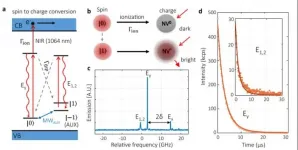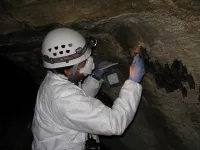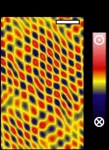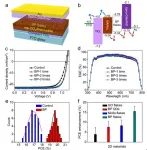NASA OSIRIS-REx's final asteroid observation run
2021-04-01
(Press-News.org) NASA's OSIRIS-REx mission is on the brink of discovering the extent of the mess it made on asteroid Bennu's surface during last fall's sample collection event. On Apr. 7, the OSIRIS-REx spacecraft will get one last close encounter with Bennu as it performs a final flyover to capture images of the asteroid's surface. While performing the flyover, the spacecraft will observe Bennu from a distance of about 2.3 miles (3.7 km) - the closest it's been since the Touch-and-Go Sample Collection event on Oct. 20, 2020.
The OSIRIS-REx team decided to add this last flyover after Bennu's surface was significantly disturbed by the sample collection event. During touchdown, the spacecraft's sampling head sunk 1.6 feet (48.8 centimeters) into the asteroid's surface and simultaneously fired a pressurized charge of nitrogen gas. The spacecraft's thrusters also mobilized a substantial amount of surface material during the back-away burn. Because Bennu's gravity is so weak, these various forces from the spacecraft had a dramatic effect on the sample site - launching many of the region's rocks and a lot of dust in the process. This final flyby of Bennu will provide the mission team an opportunity to learn how the spacecraft's contact with Bennu's surface altered the sample site and the region surrounding it.
The single flyby will mimic one of the observation sequences conducted during the mission's Detailed Survey phase in 2019. OSIRIS-REx will image Bennu for 5.9 hours, which is just over a full rotation period of the asteroid. Within this timeframe, the spacecraft's PolyCam imager will obtain high-resolution images of Bennu's northern and southern hemispheres and its equatorial region. The team will then compare these new images with the previous high-resolution imagery of the asteroid obtained during 2019.
Most of the spacecraft's other science instruments will also collect data during the flyover, including the MapCam imager, the OSIRIS-REx Thermal Emission Spectrometer (OTES), the OSIRIS-REx Visible and Infrared Spectrometer (OVIRS), and the OSIRIS-REx Laser Altimeter (OLA). Exercising these instruments will give the team a chance to assess the current state of each science instrument onboard the spacecraft, as dust coated the instruments during the sample collection event. Understanding the health of the instruments is also part of NASA's evaluation of possible extended mission opportunities after the sample is delivered to Earth.
After the Bennu flyby, it will take several days for the data from the flyover to be downlinked to Earth. Once the data are downlinked, the team will inspect the images to understand how OSIRIS-REx disturbed the asteroid's surface material. At this point, the team will also be able to evaluate the performance of the science instruments.
The spacecraft will remain in asteroid Bennu's vicinity until May 10, when the mission will enter its Return Cruise phase and begin its two-year journey back to Earth. As it approaches Earth, the spacecraft will jettison the Sample Return Capsule (SRC) that contains the rocks and dust collected from Bennu. The SRC will then travel through the Earth's atmosphere and land under parachutes at the Utah Test and Training Range on Sep. 24, 2023.
Once recovered, the capsule will be transported to the curation facility at the agency's Johnson Space Center in Houston, where the sample will be removed for distribution to laboratories worldwide, enabling scientists to study the formation of our solar system and Earth as a habitable planet.
INFORMATION:
NASA's Goddard Space Flight Center in Greenbelt, Maryland, provides overall mission management, systems engineering, and the safety and mission assurance for OSIRIS-REx. Dante Lauretta of the University of Arizona, Tucson, is the principal investigator, and the University of Arizona also leads the science team and the mission's science observation planning and data processing. Lockheed Martin Space in Denver built the spacecraft and provides flight operations. Goddard and KinetX Aerospace are responsible for navigating the OSIRIS-REx spacecraft. OSIRIS-REx is the third mission in NASA's New Frontiers Program, which is managed by NASA's Marshall Space Flight Center in Huntsville, Alabama, for the agency's Science Mission Directorate in Washington.
For more information about this story and OSIRIS-REx visit: https://www.nasa.gov/osiris-rex
By Brittany Enos
University of Arizona
Media Contact:
Rani Gran
NASA Goddard Space Flight Center, Greenbelt, Md.
Rani.C.Gran@nasa.gov
[Attachments] See images for this press release:

ELSE PRESS RELEASES FROM THIS DATE:
2021-04-01
PROVIDENCE, R.I. [Brown University and Providence Veterans Affairs Medical Center] -- Brain-computer interfaces (BCIs) are an emerging assistive technology, enabling people with paralysis to type on computer screens or manipulate robotic prostheses just by thinking about moving their own bodies. For years, investigational BCIs used in clinical trials have required cables to connect the sensing array in the brain to computers that decode the signals and use them to drive external devices.
Now, for the first time, BrainGate clinical trial participants with tetraplegia have demonstrated use of an intracortical wireless BCI with an external wireless transmitter. The system is capable of transmitting brain signals at single-neuron resolution and ...
2021-04-01
Few compounds are as important to industry and medicine today as titanium dioxide. Despite the variety and popularity of its applications, many issues related to the surface structure of materials made of this compound and the processes taking place therein remain unclear. Some of these secrets have just been revealed to scientists from the Institute of Nuclear Physics of the Polish Academy of Sciences. It was the first time they had used the SOLARIS synchrotron in their research.
It is found in many chemical reactions as a catalyst, as a pigment in plastics, paints or cosmetics and in medical implants it ...
2021-04-01
The team led by Professor DU Jiangfeng and Professor WANG Ya from the Chinese Academy of Sciences (CAS) Key Laboratory of Microscale Magnetic Resonance of the University of Science and Technology of China put forward an innovative spin-to-charge conversion method to achieve high-fidelity readout of qubits, stepping closer towards fault-tolerant quantum computing.
Quantum supremacy over classical computers has been fully exhibited in some specific problems, yet the next milestone, fault-tolerant quantum computing, still requires the accumulated logic gate error and the spin readout fidelity to exceed the fault-tolerant threshold. DU's team has resolved the first requirement in the nitrogen-vacancy (NV) center system ...
2021-04-01
Pollen from trees, grasses and weeds are causing seasonal allergies for approximately one fifth of the Swiss population every year. A study now found that due to climate change, the pollen season has shifted substantially over the past 30 years in onset, duration and intensity. "For at least four allergenic species, the tree pollen season now starts earlier than 30 years ago - sometimes even before January," said Marloes Eeftens, Principal Investigator and Group Leader at Swiss TPH. "The duration and intensity of the pollen season have also increased for several species, meaning that allergic people not only suffer for a longer period of time but also react stronger to these higher concentrations."
The researchers analysed pollen data from 1990 ...
2021-04-01
The risk is low that scientists could pass coronavirus to North American bats during winter research, according to a new study led by the U.S. Geological Survey. Scientists find the overall risk to be 1 in 1,000 if no protective measures are taken, and the risk falls lower, to 1 in 3,333 or less, with proper use of personal protective equipment or if scientists test negative for COVID-19 before beginning research.
The research specifically looked at the potential transmission of SARS-CoV-2, which is the type of coronavirus that causes COVID-19, from people to bats. Scientists did not examine potential ...
2021-04-01
University of Warwick physicists set out to find Skyrmions, only to find near-identical object with distinctive qualities that they have named an incommensurate spin crystal
Scientists looked for the signs of the magnetic spin texture in ultra-thin materials only a few atoms thick
Physicists have great interest in the potential of Skyrmions frequently detected by their ambiguous, bulk electrical measurements.
This new discovery could point the way for a new basis for technologies in computer memory and storage
Physicists on the hunt for a rarely seen magnetic spin texture have ...
2021-04-01
A study led by Queen Mary University of London researchers has compared the performance and acceptability of a urine test and four different vaginal self-sampling collection devices to detect high risk Human Papilloma Virus (HPV).
Corresponding author Professor Jack Cuzick from Queen Mary University of London said: "Uptake of cervical screening has been declining in the UK in recent years, and self-sampling is an attractive alternative to clinician collected samples, initially in non-attenders but potentially for all women as the primary option.
"Cost and simplicity of use are important factors, and in low- and middle-income countries self-sampling may prove to be the only practical cost-effective ...
2021-04-01
Grain boundaries (GBs) in PSCs have been found to be detrimental to the photovoltaic performance of the devices. Numerous papers reported that the defects in perovskite GBs should be passivated by suitable materials, such as quaternary ammonium halide, fullerene derivatives and CH3NH3I, to alleviate carrier recombination and consequently improve the device performance.
In a new paper published in Light: Science & Applications, a team of scientists, led by Professor Feng Yan from Department of Applied Physics, The Hong Kong Polytechnic University, Hung Hom, Kowloon, Hong Kong, and co-workers have developed a novel method to overcome the drawback of perovskite GBs without ...
2021-04-01
Many slopes in the Campania region are covered with layers of volcanic soil, the result of repeated eruptions over the course of millennia. As the impacts of climate change worsen, including the occurrence of very intense and short rainfall in localized areas, there is a growing need, especially in this and other Italian regions that are vulnerable to landslides, to understand the dynamics that induce such events more precisely and develop models that can predict them. When employed through adequate early warning systems, these tools can support decision-makers in adopting effective and efficient measures to protect people and the areas themselves from landslides.
To ...
2021-04-01
The human body is an incredibly designed machine, and mechanical processes such as those in the lymphatic system play major roles in maintaining healthy tissue and organs.
Donny Hanjaya-Putra is an assistant professor whose work lies at the intersection of engineering and medicine. He studies the lymphatic system -- the part of the immune system that rids the body of toxins and other unwanted materials. He looks at how to restore dysfunctional lymphatic networks, which are associated with a wide range of diseases, including cancer, cardiovascular disease, diabetes, neurological conditions and metabolic syndromes.
Now Hanjaya-Putra and his team -- bioengineering doctoral student Laura Alderfer, along with Elizabeth Russo, a 2019 graduate; ...
LAST 30 PRESS RELEASES:
[Press-News.org] NASA OSIRIS-REx's final asteroid observation run






